
A series of development initiatives for future development are outlined in the 13th Malaysia Plan.
While many of these have received widespread approval and are positive in nature, some suggestions and measures have raised concerns and controversy.
The most intense public backlash is undoubtedly directed at the Employees Provident Fund (EPF) for its study on the implementation of monthly retirement withdrawals.
According to the report, the government will focus on reforming the EPF scheme by exploring a split of contributions into two parts: a withdrawable savings portion and a monthly pension to be disbursed after retirement.
The intention of the government to replace the lump-sum withdrawal scheme with a monthly one is to ensure a stable retirement income and retirement life.
While the intention is good, this “paternalistic” measure has not been well-received by the public.
Data released by the EPF at the end of 2023 shows that out of 16.07 million members, only 8.52 million are active. Approximately 52 percent of these members have less than RM10,000 in their accounts.
What’s more concerning is that a staggering 27 percent of members, who are already 54 years old, have less than RM50,000 saved.
In addition, a report released by Khazanah Research Institute, “The state of households 2024: Households and the pandemic from 2019-2022,” indicates that over 90 percent of EPF members under the age of 30 will not be able to reach the basic savings target of RM240,000 by the time they retire.
The backlash from EPF members is understandable. They have saved for their entire lives and want to have control over their retirement funds, not to be restricted by the government.
These statistics reveal a harsh reality: EPF members will face severe challenges in their later years.
Besides insufficient savings, whether members use their funds wisely is also a problem.
According to EPF data, one in four members depletes their EPF savings within five years of reaching the withdrawal age. This suggests that some members might fall into hardship in their later years.
Furthermore, many retirees have lost their pension funds to scammers after receiving their withdrawals, leaving them devastated.
These various situations form the basis for the government to look into the EPF withdrawal system, with Malaysia’s aging population also a key consideration.
However, the public have “noted” the good intention of the government and have expressed a strong stance of “my EPF so I decide.”
In truth, restricting members from withdrawing all their EPF savings is not a new or unprecedented idea; other countries, including Singapore have similar restrictions aimed at protecting members in having a stable retirement life.
The backlash from EPF members is understandable. They have saved for their entire lives and want to have control over their retirement funds, not to be restricted by the government.
This presents a dilemma. While the intention of the government is good, it must also consider the members’ rights.
Before making a final decision, the authorities must not only conduct thorough research but also listen to the members, understand their perspectives and seek a consensus.
Perhaps the government could consider avoiding a “one-size-fits-all” approach that completely bans lump-sum withdrawals. Instead, it could set reasonable conditions that allow eligible members to withdraw their full savings.
After all, this is only a proposal in its study phase, with offering secured retirement lives of members in mind. All parties should engage in rational discussion.
The key is that the final outcome must prioritize the interests of the members and their views must be respected.
ADVERTISEMENT
ADVERTISEMENT







































